|
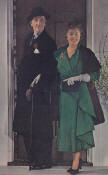 A comedy in three acts by S.N. Behrman, suggested by an
original story by Somerset Maugham. Opened at the Coronet Theatre, New York
City, February 1, 1952, and ran through April 26 (100 performances). Produced
by the Theatre Guild, Inc., under the supervision of Theresa Helburn and
Lawrence Langner. Directed by Cyril Ritchard and Associate Director Armina
Marshall. Company Manager, Peter Davis; Stage Manager, George Greenberg; Asst.
Stage Manager, Al Collins; Master Electrician, Chris Bradley; Wardrobe
Mistress, Hallye Clogg. A comedy in three acts by S.N. Behrman, suggested by an
original story by Somerset Maugham. Opened at the Coronet Theatre, New York
City, February 1, 1952, and ran through April 26 (100 performances). Produced
by the Theatre Guild, Inc., under the supervision of Theresa Helburn and
Lawrence Langner. Directed by Cyril Ritchard and Associate Director Armina
Marshall. Company Manager, Peter Davis; Stage Manager, George Greenberg; Asst.
Stage Manager, Al Collins; Master Electrician, Chris Bradley; Wardrobe
Mistress, Hallye Clogg.
Setting and costumes designed by Elfi von Kantzow. Miss
Best's gowns by Valentina. Miss Browne's gowns by Bergdorf-Goodman. Miss
Corri's gowns by Claire McCardell. Miss Best's coiffure by Ronald De Mann.
Scenery built and painted by Cherokee Construction Company. English
furniture and silver by Philip Colleck of London. Miss Best's second act
rhinestone jewelry by Mazer Bros., Inc. Miss Browne's jewelry by Milton E.
Brown & Co. Luggage by Wings Luggage Co. Drapery fabric by Jofa, Inc. Park
and Tilford products used. Still photos by Vandamm Studio.
|
Cast of Characters
|
Ann Tower |
Adrienne Corri |
|
Peter Crewe |
William Whitman |
|
Wilson |
Al Collins |
|
William Tower |
Basil Rathbone |
|
Millicent Tower |
Irene Browne |
|
Jane Fowler |
Edna Best |
|
Maid |
Sarah Marshall |
|
Lord Frobisher |
Howard St. John |
|
Gilbert Dabney |
Philip Friend |
| |
|
|
| |
|
| |
Setting: The entire action takes place in Mrs. Tower's drawing
room, Regents Park, London. |
| ACT I |
September 1937 |
| ACT II |
Late March 1938 |
| ACT III |
Ten days later |
|
|
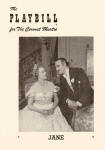
playbill |
|
Based on a short story by W. Somerset Maugham, the comedy Jane was first
written in 1946, and performed in London in 1947. It was not performed on Broadway until 1952.
Basil Rathbone's character,
William Tower, is a writer, and is based on W. Somerset Maugham. In fact, the
stage directions state: "The actor who plays William Tower would do well to
study the portraits and read the works of W. Somerset Maugham. . . . Tower wears
a monocle on a broad black ribbon with which he habitually fixes people." [from The Best Plays of 1951-52,
ed. by Burns Mantle (Dodd, Mead and Co., 1952), p. 210]
In Act I we learn that William Tower's daughter Ann and her boyfriend Peter, a
poet, are in love. Their relationship faces two challenges, however: 1) Ann's
mother can't stand Peter, and she hopes that her ex-husband Willie can do
something to break up Ann and Peter; and 2) Peter has married a girl in order
for her to obtain a passport. She was being persecuted because of her father's
political opinions, and is now in a concentration
camp.
Mrs. Tower is horrified to learn that her
middle-aged sister-in-law Jane Fowler will arrive shortly. Jane, the widow of Mrs. Tower's
brother, appears old and frumpy, an actual "plain Jane." Mrs. Tower declares, "She looks twenty years older than I do and she's perfectly capable of
telling anyone she meets that we were at school together. When she comes to
London it never occurs to her to stay anywhere but here—she thinks it would hurt
my feelings."
Also visiting are Willie Tower, who has just returned from a trip to Africa, and Lord Frobisher, a
friend and chain-paper publisher. Jane gets along well with Willie. She
surprises everyone by announcing that she is going to get
married. Her intended (Gilbert Dabney) is about 30 years old, so everyone assumes that he is
marrying Jane for her money.
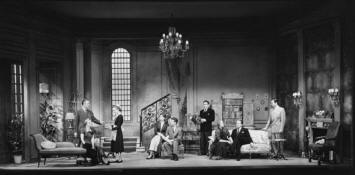
Mrs. Tower's drawing room
Act II takes place six months later.
Peter has had a book of poems published, so he is enjoying some success as a writer.
Jane, who had been dowdy and dull, is now the reigning social success of
London. She describes her young husband Gilbert as
"old-fashioned."
Jane appeals to
Lord Frobisher to use his influence to get Peter's wife out of the prison camp. Jane
offers to pay the costs, if only Frobisher can make the arrangements. Then Peter
and his wife can get a divorce, and Peter will be free to marry Ann Tower.
When Gilbert hears about Jane's meddling in Peter's business, he is angry with
her. He decides to take Mrs. Tower to the opera instead of Jane. Willie Tower invites Jane
and Frobisher to dinner.
When the curtain rises for
Act III, it is ten days later. Tower speaks to Jane, expressing concern for Ann
and Peter. Jane says she plans to adopt Peter's wife, who is out of prison and
on her way to England. Gilbert responds to this news by saying, "This time Jane
has gone too far."
After confronting Jane, Gilbert leaves her.
Frobisher comes in just as Gilbert
is leaving, and Tower explains what happened. "Serves her
right," remarks Frobisher. Tower observes that Frobisher is so rude to Jane that he must be very
taken with her. Tower appalls Frobisher by suggesting that he might enjoy being
married to Jane. "Last man on earth for anyone to marry," says Frobisher. Tower states
that he'd be a better husband than Frobisher, and the two men continue to banter about who
should marry Jane.
The play ends with Jane admitting that she loves Frobisher, and he proposes.
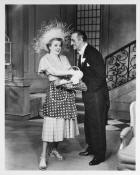
Rathbone and Irene Browne |
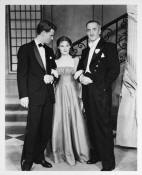
William Whitman,
Adrienne Corri, Basil Rathbone |
The cast, which included Irene Browne from the London cast, began rehearsals
in mid-December 1951.
Howard St. John and Edna Best had participated in a tryout of the play at the
Westport Country Playhouse (Westport, Connecticut) the previous July. At that
time the play was called "The Foreign Language."
In early 1952,
Jane had pre-Broadway tryouts at the Playhouse in Wilmington, Delaware
(January 10) and at the Walnut St. Theatre in Philadelphia, Pennsylvania (January 14-26).
Earnings the first week in Philadelphia were only fair, and they did not pick up the second
week. As a result, management decided to hold the show in Philadelphia for three
extra days instead of moving to Hartford as planned. The three extra
performances were January 28, 29, and 30.
When Jane opened on Broadway February 1, 1952, one critic then wrote: ''High comedy has almost vanished
from the American theater, which for the past few seasons has been so busy with
problems and depressing people that it has almost forgotten how to induce
laughter.'' —from the New York Times, June 14, 1987
The character of William Tower, was fashioned after W. Somerset Maugham, the
author of the short story from which the play was adapted. Tower's ex-wife,
Millicent, was patterned after Maugham's wife, Syrie. The character of Allan
Frobisher also had a real-life counterpart: Canadian newspaper tycoon Lord
Beaverbrook.
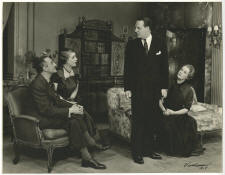
Rathbone, Irene Browne,
Howard St. John, and Edna Best |
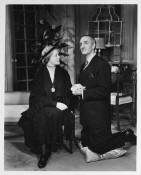
Rathbone and Edna Best |
Dramatist S. N. Behrman, one
of the Theatre Guild's foremost writers, was frequently referred to as an
American Noel Coward. In addition to Jane, he wrote
Biography, No Time for Comedy and The Second Man.
Basil Rathbone had previously acted with Edna Best in the play Melo,
which was performed on Broadway in 1931, and in a brief revival of The
Heiress, performed from February 8-19, 1950 (16 performances). In
radio, Edna Best directed some of the Sherlock Holmes episodes that
starred Basil Rathbone. She also staged Noel Coward's "Tonight at 8:30,"
a cycle of nine short plays that were performed at the El Capitan Theatre in
Hollywood in August 1940. Basil appeared in The Astonished Heart, one
of those short plays in the cycle.
The only time Basil Rathbone acted with Howard St. John,
Philip Friend, and the rest of the cast was on the stage in this
production of Jane.
Behrman's "Jane" Sparkles Wit, But Somewhere
a Play is Missing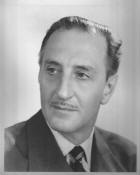
No playwright around these days can handle a comedy of manners better than S.N.
Behrman, and it is a treat again to listen to a polished, witty dialog. He has
put a lot of it into his comedy Jane." Conversationally, it sparkles a great
deal of the time. But unfortunately its premise is frail and rather silly, and
gets nowhere beyond engendering a certain genial warmth—certainly not enough to
put the heat on the Coronet's box office for any protracted period.
Behrman's plot is based on a story of Somerset Maugham's about a middle-aged
ugly duckling who belatedly takes on swan plumage. In this case, she is an
elderly provincial widow who descends on a Mayfair menage and turns it
end-over-end via sheer charm. She marries a lad half her age, lets him desert
her, and angles herself into a third set of wedding bells with a tycoon as well
known for his bedroom antics as for his ability as a publisher. Along the way,
she serenely arranges the marital happiness of a niece, utterly confounds a
meanish sister-in-law, and almost snares a cynical brother-in-law. All of which
is accomplished in the most naively ingenious manner, even if it is quaintly
unbelievable. It is, however, played for the most part on a wonderfully brittle,
high-comedy plane by its principals.
Edna Best creates a delightful portrait of the guilefully guileless
lady who charms by merely telling the truth. She is particularly adept at
this type of comedy. Adept, also, is her co-star, Basil Rathbone. As a
sort of bystander to the story, in which he gets involved in spite of
himself, Rathbone plays one of Maugham's typical suave, cynical writing
men.
You do not often meet a man with such a singularly continuous flow of wit,
but Behrman has given him amusing
things to say, and he gets all the best out of them. But it is Howard St. John's
teaming with Miss Best which gives the play its best moments. The former's
growing frustration as a self-confessed roue, as he falls under the lady's
spell, are real high spots in an otherwise conversational evening.
Irene Browne contributes excellently as a Mayfair divorcee with all the silly
conceits and deceits of her class, and Philip Friend plays the selfish young
husband who walks out on Jane with a fine relish. Adrienne Corri and William
Whitman pair adequately in the secondary love interests which is the basis of
the frail plot.
Having knowing players to work with, plus a high-comedy perception of his
own, Cyril Ritchard has staged these drawing-room doings effectively, although
there are considerable stretches of chit-chat that get his inventiveness down.
The Theater Guild has given "Jane" a plush production, with a high-power Hyde
Park drawing-room background by Elfi von Kantzow who is also responsible for
costumes, except those supplied for Miss Best's metamorphosis by Valentina. It
is too bad that there is not a better play to go with it all.
Bob Francis
—Billboard,
February 9, 1952 |
"Jane ... is a wise or, at least, very clever comedy, weak
during the first half of the second act but decidedly a relief from humdrum
writing. Whether it could have any effect with a cast that has no actors
comparable to Edna Best, Basil Rathbone, Howard St. John, and Irene Browne is
another matter." —John Gassner, "Broadway in
Review," Educational Theatre Journal, May 1952
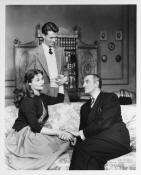
Rathbone,
Adrienne Corri, William Whitman |
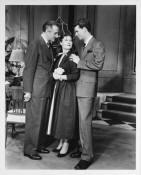
Rathbone,
Adrienne Corri, William Whitman |
"Edna Best is brilliant in the title role, making thoroughly plausible the great
change in the character that occurs between the first and second act. Basil
Rathbone gives a suave, polished reading of the role of William Tower, the
cynical author." —Variety, January 16, 1952
QUERY: WHAT MAKES COMEDY HIGH?
By S. N. BEHRMAN
Dramatist, Scenarist, Biographer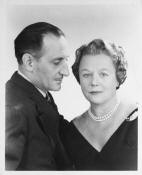
I know that the press agent for my new play at the Coronet Theatre will be
unhappy if I don't mention "Jane," and it is a primary function of the
playwright to keep the press agent in amiable spirits. Maugham's short story, on
which the play is based, tells about an elderly frump from Liverpool who marries
a very young and very attractive man. Miss Theresa Helburn of the Theatre Guild
wished me to adapt it. Mr. Maugham, who is one of the canniest of men, has sold
the film rights to everything he has ever written—he has recently even been
selling the rights to his fascinating personality; but he never sold the film
rights to "Jane," although it is over thirty years old; because he felt that it
would one day make a play.Difficult Task
Although he is a brilliant playwright, he did not want to dramatize it himself
because he has long since quit the theatre, which is perhaps an even profounder
demonstration of his canniness. It looked to me like an attractive job but it
was very hard to do. The theatre is the most naked of mediums; it is a
two-and-a-half-hour close-up, and questions which Maugham never had to
answer—nor even to raise—in the compass of a short story, pop up uncomfortably
when you come to write a play. Why does a sensible woman like Jane marry a man
so much younger? Maugham describes her as witty and as making a sensation by
always telling the truth. Nice work if you can get it!
Also, and this is the nub, instead of the young man's eventually leaving Jane,
as everyone predicts, Jane leaves the young man. This was a puzzler. Why? I gave
this as much thought as Newton and Satan gave the apple—with somewhat less
epochal results. One line gave the play to me and the answer. When Gilbert asks
Jane why she is leaving him, she says: "Because you are too old for me!" This
line was, originally, the curtain of Act Two, the climax of the play. In the
prolonged neurasthenic hypochondria which constitutes a try-out tour, I allowed
this line to be shifted to Act Three. The point I wanted to make in the play is
that youth is a question of vitality, generosity, warmth and general sympathy in
point of view. A stuffed shirt may be old at 20. Jane is alive and vital and
will be young at 80.
—The New York Times, March
30, 1952 |
"While some of the lines in "Jane" are funny and some are not, they all have
the same sort of surface quality; all of them are delivered—by
the members of an efficient cast, who are not paid to scratch beneath this
surface—as though they were bon mots;
and the audience laughs reflexively, though cordially, at each invitation. ...
There are two fine performances, by Edna Best and Howard St. John, and two
others, by Basil Rathbone and Irene Browne, that are faintly ridiculous, but
amusing." —John Lardner, The New Yorker,
February 9, 1952
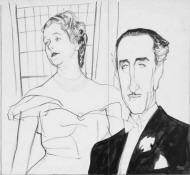
Edna Best and Basil Rathbone
drawing by William Auerbach-Levy, 1952 |
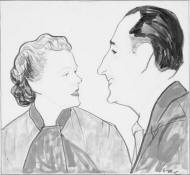
Edna Best and Basil Rathbone
drawing by William Auerbach-Levy, 1952 |
"This is an idle romp in an English drawing room in 1938, when the world was
just getting ready to explode. Standards of responsible behavior are hinted at
occasionally. ... The character Mr. Behrman is fondest of is a fiction and comedy writer
called 'Willie' who stands just outside the action, observing it with
mischievous relish. Rich, elegant, sagacious, impeccable in his choice of words,
he represents W. Somerset Maugham, master of the genre. When Jane was produced
in London Mr. Maugham may have been astonished to find himself moving through
the ballet pattern of one of his own stories, cautiously dissociating himself
form the social dilemmas it chronicles. Since Mr. Behrman's talents as prose
writer are equivalent to Mr. Maugham's, there is no sycophancy in the portrait.
On the contrary, there is some shrewd criticism and some genial satire of Mr.
Maugham's disdainful point of view. But it is a portrait written with respect
and understanding as well as humor and it emerges as the most winning character
in the play.
Mr. Rathbone is ideal in the part. He is crisp, immaculate and good humored, and
he speaks some elaborately written lines with wry punctilio."
—Brooks Atkinson,
The New York Times, February 10, 1952
|
Plays on Broadway
Jane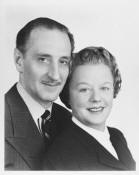
"Jane" is a mass of contradictions. It has a droll premise, an awful lot of talk
and considerable wit, but isn't much of a play. It's expertly played and deftly
staged, but it frequently seems pretty hollow. Its characters appear to be
rather shallow, but they're mostly inclined to be likeable at heart. The show
itself should have a moderately good run, but isn't likely to have mass
popularity.
In style and treatment, "Jane" is characteristic of its authorship. It was
dramatized by S. N. Behrman ("suggested by," the program expresses it) from a
story of W. Somerset Maugham, and is a suave, wise, amusing but strangely
synthetic yarn that never quite seems to achieve concrete form or reality. Bu
artful handling makes it palatable, if not superlative entertainment.
The story, somehow not entirely credible, is about a dowdy, middle-aged
Liverpool widow who marries a penniless young architect, blossoms out in glad
rags and becomes the rage of London smart set on the novelty of her directness
instead of the usual small talk. After that diverting start, however, "Jane"
becomes somewhat murky in plot and characterization, and is less satisfying
theatre.
As title actress and top star, Edna Best gives a superb comedy performance that
is primarily responsible for saving the show. Her bland, deceptively mild style
of comedy playing is hilarious and, teamed with the crisp manner of Basil
Rathbone, her co-star, or the emphatic impact of Howard St. John, is
irresistible. Rathbone gives definition to the role of a sardonic foreign
correspondent-novelist-playwright (said to be at least a semi-portrait of
Maugham), while St. John is funny if not too convincingly self-satisfied or
arrogant as a self-indulgent newspaper magnate.
Irene Browne presents a shrewdly comic portrait of a fashionable feline divorcee
and Philip Friend gives a genuinely skillful performance in the difficult part
of Jane's "young man." Among the non-featured parts, Adrienne Corri is
believable as a rather stereotype heroine, William Whitman is plausible as her
impractical fiance, and Al Collins and Sarah Marshall (the latter the daughter
of Miss Best and ex-husband Herbert Marshall) are acceptable in bit assignments.
Cyril Ritchard's staging is perceptive and has an infectious flavor. The Elfi
von Kantzow drawing room setting has the traditional brightness for comedy, but
doesn't look like the sort of interior any normal playgoer is ever apt to see
outside a theatre. Valentina's gowns for Miss Best are scrumptious.
Hobe.
—Variety, February 6, 1952 |
"A cast of experts in smart comedy make the most of every twist and sally with
Basil Rathbone, as a replica of Mr. Maugham, alerted to
inject the expected bit of cynicism."
—Catholic World, March 1952
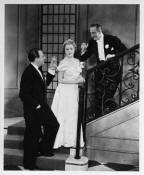
Howard St. John, Edna Best and Basil Rathbone |
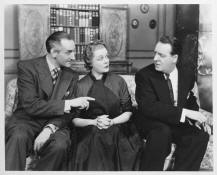
Basil Rathbone, Edna Best, and Howard St. John |
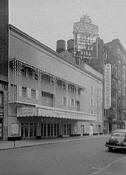
The
Coronet Theater in 1945 |
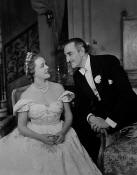
Edna Best and Basil Rathbone |
The theater where the play Jane was performed opened as the Forrest Theatre
in 1925. Located at
230 West 49th Street, it was renamed the Coronet Theater in
1945, and the Eugene O'Neill Theater in 1959. |























